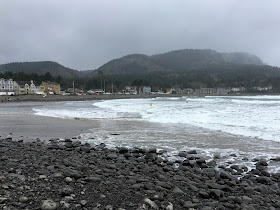Last week I got a chance to visit Cama Beach to talk to this spring's Sound Water Stewards class. The weather cooperated for the beach walk - which it seems like it usually does, but this year I wasn't so sure! I managed to grab a few photos, but not many. When I'm with a group, I'm too busy answering questions or looking for topical material to remember to take pictures.
AERIAL VIEW
The beach at the south end is very low, although not necessarily lower than in 2012 (Cama Beach: May 2009). However, a little farther north, near the old gate in the seawall, it was as low as I've ever seen it. The old wooden piles were completely exposed and there were large patches where the beach veneer was completely absent, with the underlying silt and clay showing through.
At the north end, we checked out the two big slide scars from previous years (see linked posts below). Despite this winter's record rainfall, it doesn't look there's been that much activity.
There was eelgrass hanging from the branches of the trees - a reminder of the interaction between the terrestrial and marine ecosystems. And there was a wonderfully delicate micro-berm of ground up clam shell marking last night's high tide.
Previous posts that mention Cama Beach.

Hug Point is a small rocky headland that extends out across the beach a few miles south of Cannon Beach. The rocks include both Tertiary sediments and an intrusion of Columbia River basalt. 100 years ago, travel along the coast generally used the beach, but at Hug Point, a road was carved into the promontory (the old roadbed doesn't show in these photos).
AERIAL VIEW
Fall Creek arrives at the beach over an 8' waterfall. As streams often do on these kinds of beaches, it exposed the coarse cobble that underlies the upper part of the more ephemeral sandy beach.

Cannon Beach extends south from Tillamook Head and Ecoloa State Park. It's best known, visually and geologically, for Haystack Rock, a very large sea stack located just offshore, yet still accessible during low tides. Haystack Rock is Columbia River basalt, extruded into the surrounding sediments as the flows reached the former coast and then subsequently exposed by erosion.
AERIAL VIEW
Cannon Beach seems to be several communities stretched out along the shore. The northern end is very low - a barrier beach associated with the mouth of Ecola Creek. But much of the rest of the town to the south lies on somewhat higher ground behind a modest bluff, although I'm not sure if this is a marine terrace or just old dunes.
Indian Beach, in Ecola State Park, is a two kilometer long pocket beach tucked into the southern side of Tillamook Head. The upper beach is a very steep coarse gravel and cobble berm - the lower beach is flat and sandy.
AERIAL VIEW
A small stream empties out onto the northwest end of the beach. And a landslide (or several landslides) empty out onto the other end of the beach. The cliffs that rise behind the beach is Columbia River Basalt that flowed out to the coast 15 million years ago, before the modern coast range was established.
South of Seaside, the wide sandy beach runs into the rocky headland of Tillamook Head, which projects westward into the Pacific. But even this northern edge of the headland has a beach, it's just a very different one. The lower beach is rounded boulders and the upper beach is a coarse gravel and cobble berm. I assume this coarse material is all basalt, eroded from the promontory and spread eastward along it's northern shore.
AERIAL VIEW
The westerly swell sweeps along this shoreline, breaking at a very sharp angle and creating (at least under the right conditions) a strong left break just offshore. Seaside Point is a beach with a guarded, but apparently well-deserved, local reputation. During our visit, the waves seemed a little choppy and chaotic (surfers probably have a better vocabulary), but there were still a lot of surfers in the water. A strong rip develops right along the beach, making it easier for them to paddle out, but also creating a bit of a hazard.
I think the little divot in the corner (where the headland meets the main beach) is what is referred to as "the cove." The cobble beach takes an inland excursion (see aerial), leaving a sandy pocket - makes an easier entry for the surf crowd then stepping through the boulders farther out. Interestingly the cobble then continues a little farther north until it is overwhelmed by the sand (see previous post). I was curious about the origin of the cove (it's more complicated than simply being an inside corner between the north-south sandy beach and the east-west cobble beach), but so far my ideas are pretty speculative (even more speculative than usual).
The main beach in Seaside is broad and sandy, with a wide band of low grassy dunes between the promenade and the beach - enough to keep storm waves out of town, but not enough to shelter the town from a significant tsunami. The plate boundary is not far offshore - twenty minutes would be barely enough time to get to high ground under the best of conditions.
AERIAL VIEW
Seaside lies just north of Tillamook Head, at the south end of the Clatsop Dunes. This segment of beach, from Seaside north to the Columbia River is a sub-cell of the larger Columbia River cell and most of the sand on these beaches came out of the Columbia River. The other three sub-cells all lie north of the river mouth, in Washington.
The flat sandy beach in these photos is a big contrast with the cobble beaches at the very south end which I'll describe in the next post. But as you walk south - to the vicinity of "U" Avenue - a cobble berm begins to assert itself.




























